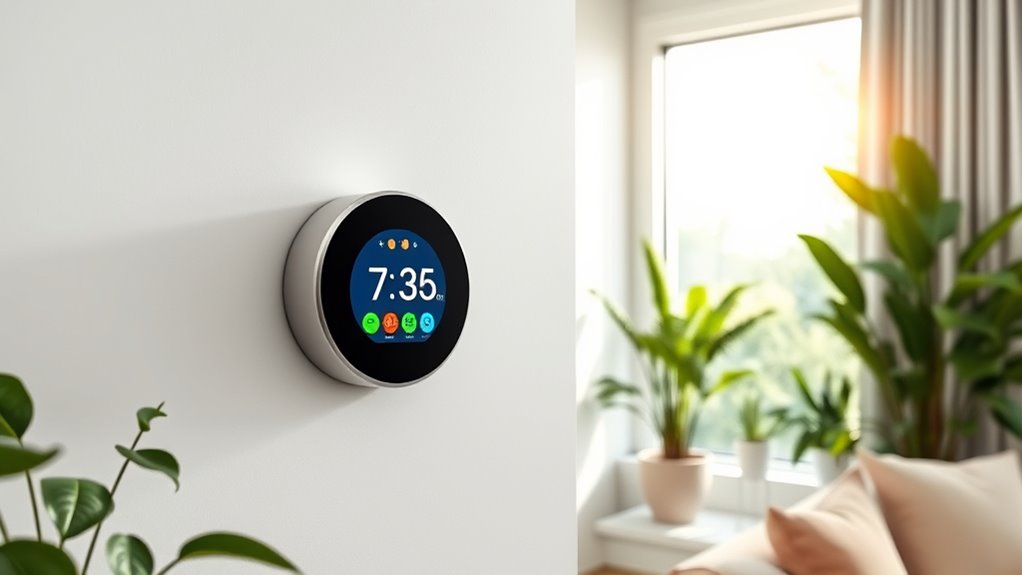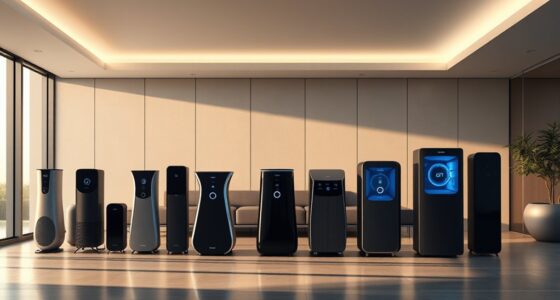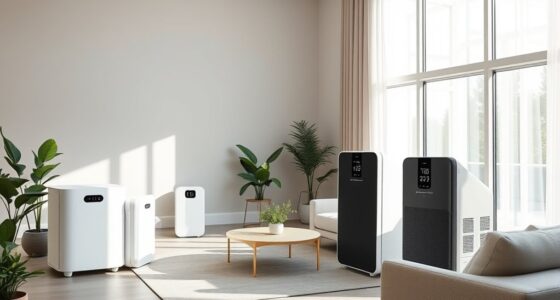If you’re looking for the best smart thermostats with air quality features, I recommend Ecobee’s models, which offer built-in air quality monitors, smart sensors, and compatibility with major voice assistants. The Ecobee Smart Thermostat Premium and Essential provide room-specific comfort and energy savings, while Amazon’s devices include detailed air quality tracking and integration with Alexa. Stay tuned as I explore each option’s unique benefits to help you create a healthier, more comfortable home environment.
Key Takeaways
- Ecobee smart thermostats feature built-in air quality monitors, alerts, and filter change reminders for healthier indoor air.
- Amazon devices provide comprehensive air quality tracking, real-time feedback, and automation options to improve air health.
- Ecobee Essential offers easy installation, smart sensors, and compatibility with major voice assistants for optimized air and climate control.
- Amazon’s smart thermostats integrate with air quality monitors and support routines to maintain cleaner indoor environments.
- Ecobee Premium models include advanced sensors and air quality alerts, ensuring balanced comfort and healthier air in your home.
ecobee Smart Thermostat Premium with Sensors and Air Quality Monitor
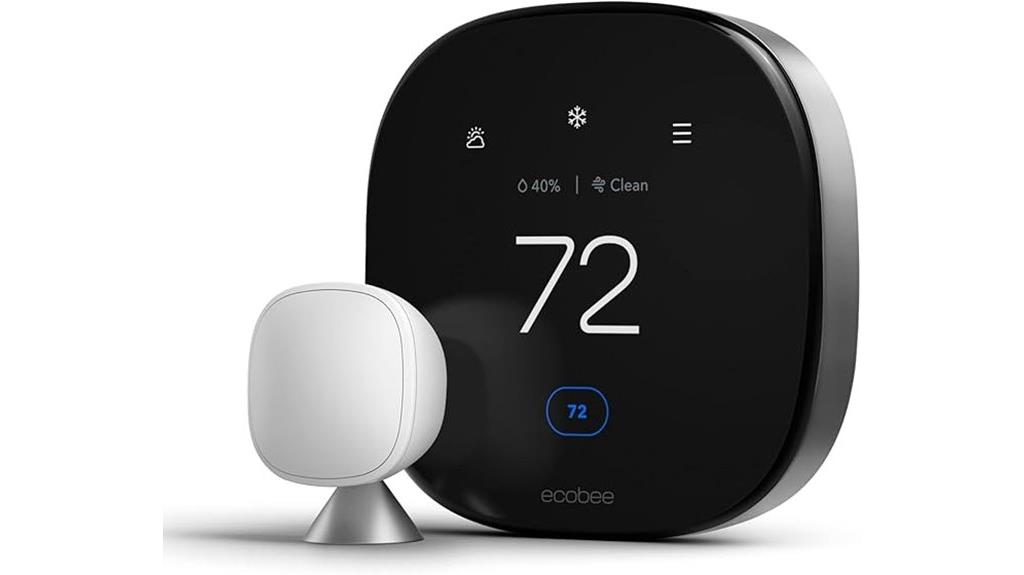
If you’re looking to improve your home’s comfort and air quality while saving on energy bills, the ecobee Smart Thermostat Premium is an excellent choice. It reduces heating and cooling costs by up to 26% annually and is ENERGY STAR certified. The included SmartSensor adjusts temperature in key rooms, eliminating hot or cold spots. Its built-in air quality monitor alerts you to poor air quality, offers improvement tips, and reminds you to change filters. With a vibrant display, advanced occupancy sensing, and home security features like smoke detection and break-in alerts, it’s a all-encompassing solution for a healthier, smarter home.
Best For: homeowners seeking to enhance energy efficiency, air quality, and security with a smart, easy-to-install thermostat.
Pros:
- Significant energy savings of up to 26% annually, reducing utility bills
- Integrated air quality monitoring and smart sensors for improved home comfort
- Compatibility with popular smart home systems like Alexa, Google Assistant, and Apple HomeKit
Cons:
- Requires compatible HVAC system and stable Wi-Fi connection for full functionality
- Can be complex to set up for non-technical users, especially with additional integrations
- Premium features and sensors may involve additional costs or subscriptions
Amazon Smart Air Quality Monitor – Know your air, Works with Alexa
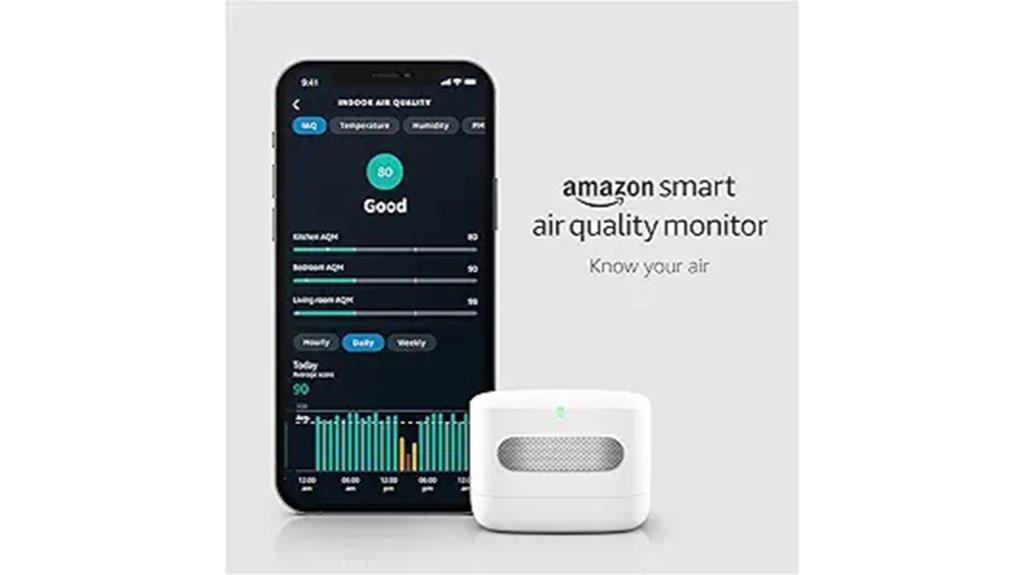
The Amazon Smart Air Quality Monitor is an excellent choice for anyone looking to enhance their home’s air quality awareness, especially those who already use Alexa-enabled devices. It tracks key factors like PM 2.5, VOCs, CO, humidity, and temperature, providing real-time updates via a color-coded LED and Alexa app scores. The device supports routine notifications and can trigger routines to activate purifiers, fans, or dehumidifiers when air quality drops. Compact and stylish, it’s easy to set up with the included cables and works seamlessly within your existing smart home ecosystem. With auto-calibration and self-cleaning features, it offers reliable, ongoing air quality monitoring.
Best For: smart home owners seeking real-time indoor air quality monitoring and automation with Alexa integration.
Pros:
- Seamless compatibility with Alexa and Echo devices for easy voice control and routine setup
- Tracks multiple air factors (PM 2.5, VOCs, CO, humidity, temperature) for comprehensive air quality insight
- Compact, stylish design with auto-calibration and self-cleaning features for reliable, maintenance-free operation
Cons:
- Limited to indoor use only, not suitable for outdoor environments
- Accuracy may vary slightly within specified ranges, requiring calibration over time
- Requires a stable 2.4GHz Wi-Fi network and compatible Alexa app version for optimal performance
ecobee Smart Thermostat Essential – Wi-Fi Programmable Thermostat
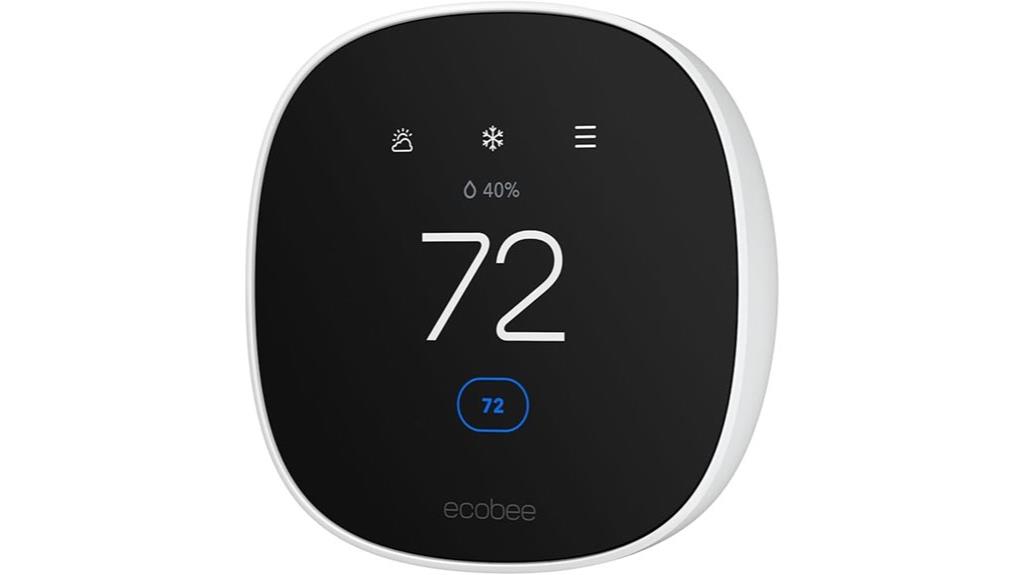
For homeowners seeking an energy-efficient thermostat that combines smart control with seamless compatibility, the ecobee Smart Thermostat Essential stands out. It’s Energy Star Certified and works with Siri, Alexa, Google Assistant, and Apple HomeKit. Installation is straightforward—no C-wire needed, thanks to the optional Power Extender Kit. The sleek LCD display and touchpad make adjustments easy, while the app lets you monitor and control your home remotely. It saves up to 23% on energy costs annually and offers features like auto-away, scheduling, and humidity detection. Plus, optional SmartSensors can enhance comfort by monitoring room-specific temperature and motion.
Best For: homeowners seeking an easy-to-install, energy-saving smart thermostat compatible with major voice assistants and smart home ecosystems.
Pros:
- Easy DIY installation with no C-wire needed, thanks to the optional Power Extender Kit.
- Compatible with Siri, Alexa, Google Assistant, and Apple HomeKit for versatile smart home integration.
- Saves up to 23% annually on energy costs, with features like auto-away and scheduling for increased efficiency.
Cons:
- Requires a separate purchase of SmartSensor for room-specific temperature and motion monitoring.
- Some users may find the small dimensions less prominent compared to larger thermostats.
- Price may vary across retailers, and features like the SmartSensor are sold separately.
Amazon Smart Thermostat
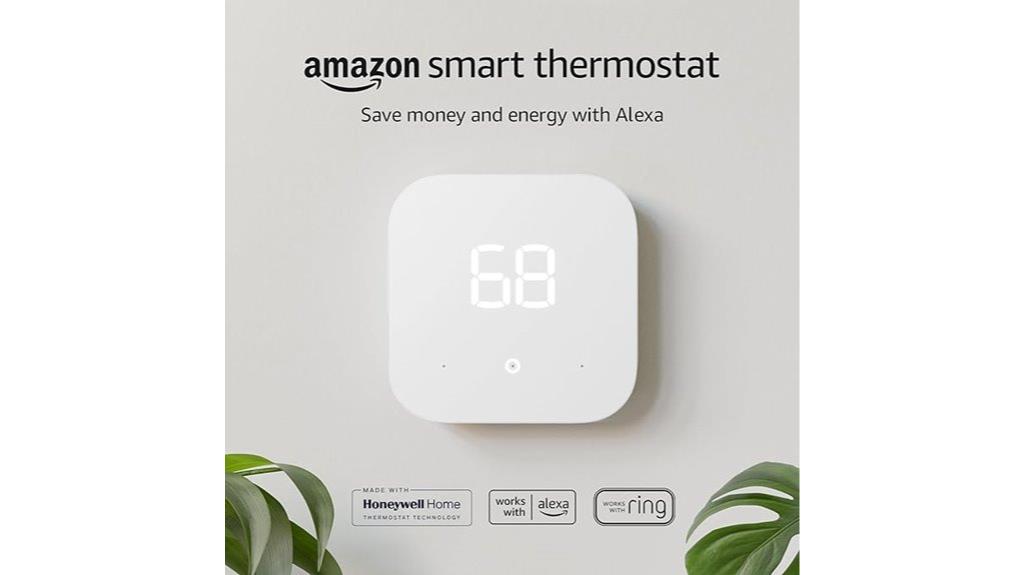
The Amazon Smart Thermostat is an excellent choice for homeowners seeking an easy-to-install, energy-efficient device that seamlessly integrates with Alexa and Ring. It requires a C-wire for installation and uses Honeywell’s trusted technology, backed by 130 years of experience. Certified ENERGY STAR, it helps save about $50 annually on energy bills by automatically adjusting temperatures based on occupancy or readings. You can control it remotely via the Alexa app or voice commands, ensuring comfort from anywhere. Plus, it supports creating comfort zones and can work with Amazon’s Air Quality Monitor for smarter environmental management. Customer support and rebate options make it an attractive, user-friendly upgrade.
Best For: homeowners looking for an easy-to-install, energy-efficient smart thermostat that integrates seamlessly with Alexa and Ring devices.
Pros:
- Compatible with Alexa and Ring for convenient voice and app control
- Certified ENERGY STAR, helping save about $50 annually on energy bills
- Supports creating comfort zones and working with Amazon’s Air Quality Monitor for smarter environmental management
Cons:
- Requires a C-wire for installation, which may not be available in all homes
- Limited to smart home ecosystems that include Alexa or Ring devices
- May need assistance from customer support or professional installation for some setups
ecobee Smart Thermostat Premium with Sensors (2-Pack)

If you’re looking to optimize both comfort and air quality in your home, the ecobee Smart Thermostat Premium with Sensors (2-Pack) is an excellent choice. It can save up to 26% annually on heating and cooling costs while earning ENERGY STAR certification. The thermostat integrates with Siri and Alexa, and features a built-in air quality monitor that alerts you to poor conditions and suggests improvements, like filter changes. The included SmartSensors help balance temperatures across rooms, preventing hot or cold spots. Plus, optional contact sensors enhance security by monitoring doors, windows, and motion, giving you peace of mind while maintaining a healthier indoor environment.
Best For: homeowners seeking to enhance comfort, air quality, and energy savings with a smart, secure thermostat solution.
Pros:
- Saves up to 26% annually on heating and cooling costs, reducing energy bills.
- ENERGY STAR certified for guaranteed energy efficiency and eco-friendliness.
- Integrates with Siri and Alexa for seamless voice control and smart home compatibility.
Cons:
- Requires a subscription to the ecobee Smart Security service to access alert features.
- May be more expensive upfront compared to basic thermostats.
- Some features, like alerts and sensors, depend on Wi-Fi connectivity and app integration.
Factors to Consider When Choosing a Smart Thermostat With Air‑Quality
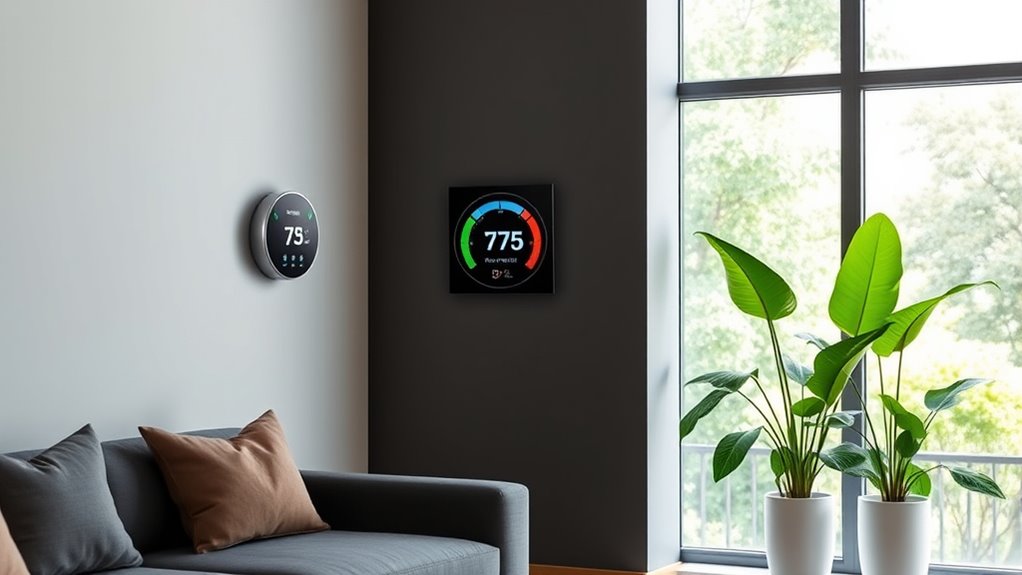
When choosing a smart thermostat with air-quality features, I look at how well it monitors air quality and whether it works with my existing system. I also consider energy-saving options and how easily it integrates with my smart home devices. These factors help me find a device that’s reliable, efficient, and fits seamlessly into my home setup.
Air Quality Monitoring
Choosing a smart thermostat with air-quality features requires careful attention to its monitoring capabilities. I look for devices that measure key pollutants like PM 2.5, VOCs, and CO, giving me a clear picture of indoor air health. Real-time data is essential, so I prefer thermostats that display color-coded indicators or app scores for instant feedback. Alerts or notifications when pollutant levels are high help me act quickly to improve air quality. Integration with other smart home devices is a bonus, enabling automatic activation of purifiers or fans in response to poor readings. I also value built-in sensors that include calibration and self-cleaning functions, ensuring the readings stay accurate over time. This combination helps maintain a healthier, safer home environment.
Compatibility With Systems
Selecting a smart thermostat with air-quality features starts with ensuring it’s compatible with my existing HVAC system and smart home setup. I need to check if it matches my system’s voltage and type, like 24VAC, heat pumps, or boilers, to avoid installation issues. Compatibility with my preferred smart home ecosystem—such as Alexa, Google Assistant, or Apple HomeKit—is also essential for seamless control. I should verify whether the thermostat includes the necessary wiring or offers a Power Extender Kit if I lack a C-wire. Wi-Fi compatibility is fundamental—whether it supports my 2.4GHz or 5GHz network—and Bluetooth, if applicable, for reliable connectivity. Finally, I need to confirm if it supports integration with additional sensors and air quality monitors I plan to use, ensuring everything works together smoothly.
Energy Saving Features
Once I’ve confirmed that a smart thermostat is compatible with my HVAC system and smart home setup, I focus on its energy-saving features. These features can cut heating and cooling costs by up to 26% annually through adaptive scheduling and automated adjustments. Occupancy sensing and geofencing are especially useful—they detect when no one’s home and automatically pause or modify temperature settings, saving energy. Programmable schedules and preheating or precooling during off-peak hours help optimize energy use throughout the day. Smart sensors placed in rooms enable targeted temperature control, preventing waste in unoccupied areas. Additionally, integration with home automation routines allows the thermostat to make dynamic adjustments based on real-time environmental data, further reducing unnecessary energy consumption and lowering utility bills.
Sensor Integration Options
When evaluating smart thermostats with air-quality features, it’s important to contemplate how well they support sensor integration. I look for models that work seamlessly with a variety of sensors—temperature, humidity, motion, and air quality—since these enhance home monitoring. Compatibility varies; some thermostats support proprietary sensors, while others connect with third-party or standard sensors via open protocols like Zigbee or Z-Wave. Proper sensor placement is key; placing sensors in major zones ensures accurate readings and better environmental control. I also consider integration options, such as smartphone apps, voice assistants, and automation platforms, which allow sensors to trigger alerts or adjust settings automatically. Finally, I check how many sensors a device supports and how easy it is to add or manage them for thorough air quality coverage.
Smart Home Compatibility
Choosing a smart thermostat with air-quality features means ensuring it plays well with your existing smart home setup. You’ll want to verify that it’s compatible with your preferred ecosystem, whether that’s Apple HomeKit, Amazon Alexa, Google Assistant, or SmartThings. Seamless voice control integration is essential, so you can manage your climate and air quality effortlessly. Make sure the thermostat supports your HVAC system type—furnaces, heat pumps, boilers, or fan coil units—so it works smoothly with your existing equipment. Connectivity options like Wi-Fi or Bluetooth are also important, ensuring reliable communication within your smart home. Additionally, look for compatibility with sensors and air quality monitors that can be integrated into your ecosystem, offering a thorough approach to home health.
Installation Ease
Installing a smart thermostat with air-quality features can be straightforward if you look for models designed with ease of setup in mind. Many models include features like a power extender kit or compatibility with existing wiring, which simplifies installation and reduces the need for complex wiring modifications. Devices supporting C-wireless installation or offering alternative power options make setup even easier. Clear, step-by-step guides with visual instructions can cut down setup time and minimize frustration. Compatibility with a wide range of HVAC systems means you often won’t need additional adapters or professional help. Some thermostats are specifically built for DIY installation, providing wall mounting templates and wire labels to make the process quick and simple, even for beginners.
Frequently Asked Questions
How Do Smart Thermostats Improve Overall Indoor Air Quality?
Smart thermostats improve indoor air quality by monitoring and adjusting temperature and humidity levels, which helps prevent mold and dust buildup. Many models also connect to air quality sensors that detect pollutants, VOCs, and allergens, allowing automatic adjustments or alerts. I find that they create a healthier environment by optimizing airflow and filtration, making my home more comfortable and reducing potential health risks from poor air quality.
Can I Control Air Quality Features Remotely via Smartphone?
Yes, you can control air quality features remotely via your smartphone. Most smart thermostats with air quality sensors come with companion apps that let you adjust settings, monitor air quality in real-time, and even set schedules from anywhere. I love being able to check my home’s air quality and tweak the system on the go, ensuring my space stays healthy and comfortable no matter where I am.
Do These Thermostats Monitor Humidity Levels as Well?
You’re asking if these thermostats monitor humidity levels. Did you know that maintaining indoor humidity between 30-50% can reduce allergens and mold growth? I’ve found many smart thermostats do track humidity, helping you optimize comfort and air quality. They often alert you when levels are off, so you can take quick action. This feature is especially useful during seasonal changes when humidity fluctuations are common, ensuring a healthier home environment.
Are Air Quality Sensors Compatible With Existing HVAC Systems?
Yes, most air quality sensors are compatible with existing HVAC systems, especially if you choose a smart thermostat designed for easy integration. I recommend checking the specific model’s compatibility before purchasing, as some may require additional adapters or professional installation. It’s worth investing in a compatible sensor to improve your home’s air quality, as it can work seamlessly with your current setup to monitor pollutants, humidity, and more.
How Often Do Air Quality Sensors Require Calibration?
Air quality sensors usually need calibration every 6 to 12 months, but it depends on the specific device. I recommend checking the manufacturer’s guidelines for your particular model. Regular calibration guarantees accurate readings, helping you maintain a healthier environment. If your sensor drifts or shows inconsistent data, it’s a good idea to calibrate sooner. Staying on top of calibration keeps your smart thermostat functioning at its best and your air quality dependable.
Conclusion
Choosing a smart thermostat with air quality features is like giving your home a gust of fresh air. It’s about smarter comfort and healthier living, all at your fingertips. Whether you go for the eco-friendly ecobee or Amazon’s reliable options, you’re better equipped to create a cozy, clean environment. So, take the leap—your home will thank you, just like a gust of crisp, invigorating air on a spring morning.
